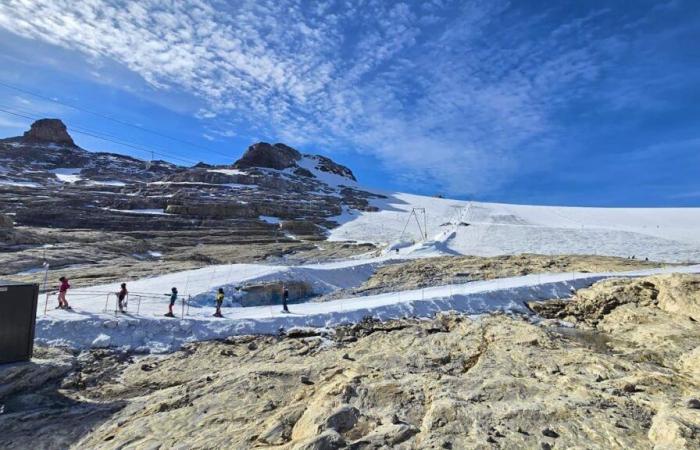The season is getting shorter, the snow limit is increasing, rain is falling more often on the slopes… If the scientific facts weren’t enough, it’s now impossible not to notice that global warming is on the rise. The winter tourism sector must now also come to terms with this and is therefore launching a battle plan to guide future developments and provide tools to stakeholders.
“There is no desire to stop developing winter tourism,” asserts Berno Stoffel, director of Swiss ski lifts. And for good reason: demand on the mountain side is not declining, and tourists are more profitable there: they spend on average 203 francs per day in winter, compared to 133 francs in summer. The mountains represent almost half of overnight stays in winter, and skiing remains the main motivation for 62% of these tourists. “Winter is crucial for these regions,” recalls Véronique Kanel, spokesperson for Switzerland Tourism. More than half of overnight stays are from Swiss; followed by almost 10% Germans, then 4% English, and the same number of Belgians as well as Americans.
But this demand is sometimes out of sync: for example, it is particularly strong at the start of the season, while the snow always arrives later, and melts earlier, confirms Adrien Michel, meteorologist at MeteoSuisse. Which points to other challenges: the 0 degree isoterm has risen by 400m since 1960, and we expect another 300m more by 2050. The snow cover is decreasing, and the “ice days”, during which it is possible to cannon, are becoming rarer, especially below 1500m. “In these places it will just be too hot.”
So, the solution? Answers will be given next summer, after coordination work carried out by Switzerland Tourism, the Association of Swiss Ski Lifts and that of Tourism Managers, with scientific, federal, cantonal and field supervision.
But the strategies are already outlined. The snow cannons will remain central, with an expected increase of 10% in artificial coverage, which will be added to the 54% of slopes already covered with snow today. With a certain cost: “technical snowmaking costs 1 million per kilometer,” explains Berno Stoffel. In some places it will be cheaper to move areas higher in altitude, where possible.” The abandonment of certain slopes at the bottom of the resort must therefore also be considered. Note that only 33% of lift companies manage to invest on their own. The price of packages will therefore be a major issue: they have already increased by 15% in ten years.
And the sector also wants to explore areas less dependent on snow. Toboganning, winter hiking, events and competitions are notably on the program. And the famous four-season tourism? “It’s very hard to develop in the summer. Customers come there for nature and calm, tourist exploitation must be discreet.”
The climate impact of tourism, the big absentee
If the reflection is focused on adaptation to the climate, the impact of winter tourism on it is far from being at the heart of the approach. Switzerland Tourism does not have global data on this subject. However, projects are underway, assures Corinne Genoud, market manager for Switzerland Tourism, such as the connection of major train lines from abroad. Transport is in fact the largest part of the carbon impact of these activities. Coordination around water resources must also be discussed, respecting clear priorities, answers Berno Stoffel to the question of the multiplication of snow cannons.
“We can be pleased that the problem is recognized,” reacts Green national advisor Christophe Clivaz. But we can also be surprised that sustainability is not taken into account more: it is sawing off the branch on which we are sitting.” And to call for a strategy not seasonal, but annual, in the development of infrastructure.






